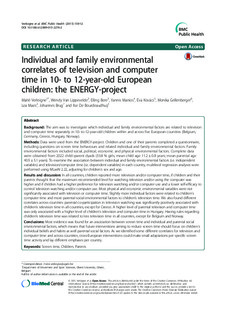| dc.description.abstract | Background: The aim was to investigate which individual and family environmental factors are related to television and computer time separately in 10- to-12-year-old children within and across five European countries (Belgium, Germany, Greece, Hungary, Norway).
Methods: Data were used from the ENERGY-project. Children and one of their parents completed a questionnaire, including questions on screen time behaviours and related individual and family environmental factors. Family environmental factors included social, political, economic and physical environmental factors. Complete data were obtained from 2022 child–parent dyads (53.8 % girls, mean child age 11.2 ± 0.8 years; mean parental age 40.5 ± 5.1 years). To examine the association between individual and family environmental factors (i.e. independent variables) and television/computer time (i.e. dependent variables) in each country, multilevel regression analyses were performed using MLwiN 2.22, adjusting for children’s sex and age.
Results and discussion: In all countries, children reported more television and/or computer time, if children and their parents thought that the maximum recommended level for watching television and/or using the computer was higher and if children had a higher preference for television watching and/or computer use and a lower self-efficacy to control television watching and/or computer use. Most physical and economic environmental variables were not significantly associated with television or computer time. Slightly more individual factors were related to children’s computer time and more parental social environmental factors to children’s television time. We also found different correlates across countries: parental co-participation in television watching was significantly positively associated with children’s television time in all countries, except for Greece. A higher level of parental television and computer time was only associated with a higher level of children’s television and computer time in Hungary. Having rules regarding children’s television time was related to less television time in all countries, except for Belgium and Norway.
Conclusions: Most evidence was found for an association between screen time and individual and parental social environmental factors, which means that future interventions aiming to reduce screen time should focus on children’s individual beliefs and habits as well parental social factors. As we identified some different correlates for television and computer time and across countries, cross-European interventions could make small adaptations per specific screen time activity and lay different emphases per country.
Keywords: Screen time, Children, Parents | nb_NO |

